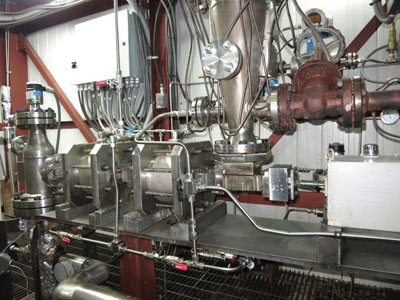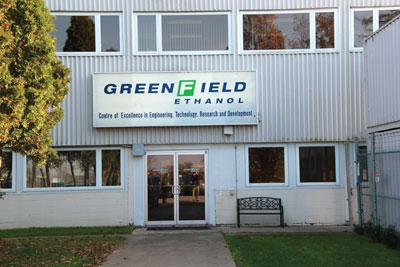
Greenfield’s Next Generation of Ethanol
February 15, 2013
By
John Tenpenny
With the ethanol fuel industry in high gear, some are looking ahead to the next generation of biofuel and at GreenField that means cellulosic ethanol.
With the ethanol fuel industry in high gear, some are looking ahead to the next generation of biofuel and at GreenField that means cellulosic ethanol.
 |
|
| Extruder No. 2 then completes the process by washing the cellulose and hemicellulose fractions, squeezing and separating the hemicellulose fraction from the cellulose fraction and contributing to the pretreatment cooking of the biomass to make the cellulose fraction more digestible.
|
The company’s Cellulosic Ethanol Division was established in 2007 to pursue research into the commercialization of cellulosic ethanol production through the biochemical conversion of plant fibers.
Currently at the company’s Centre of Excellence in Engineering, Technology, Research and Development, in Chatham, a project is underway to trial on a continuous basis its uniquely developed equipment, which Barry Wortzman, vice president of business development says will be a game-changer in the cellulosic ethanol process.
According to Wortzman, the pretreatment stage is key to any cellulosic ethanol process. At the core is a highly modified twin screw extruder, which Wortzman said can be used with various feedstocks, and is less than complex, more efficient and less costly than other pretreatment equipment alternatives.
“The result? We expect to achieve the best-in-class yield from both C5 and C6 sugars at a cost of about $2 a gallon,” he said.
GreenField’s strategy to commercialize cellulosic ethanol calls for the equipment to be validated for commercial scale-up by the end of the year, before the company begins engineering its first bolt-on cellulosic facility.
Wortzman said GreenField expects to begin building its first bolt-on plant in 2014.
He also says the company is working on a sustainable biomass supply chain, focusing on a combination of cobs/stover and purpose-grown energy crops, that includes its own trial planting program.
Pretreatment Package
Why did the company focus on pretreatment? Because it’s the key to commercialization, says Wortzman.
 |
|
| In the pretreatment process, extruder No. 1 conditions the incoming biomass by removing resins and toxins.
|
“The objective is to recover the most C5 and C6 sugars, in their cleanest form, for optimal downstream hydrolysis and fermentation. Others focused on enzymes and yeasts, but we focused on pretreatment, became experts in this field and succeeded in what we believe is a superior pretreatment process.”
GreenField pioneered a two-stage process which involves cooking the biomass in two steps. The first is to liquefy, separate and recover the C5 sugars so they will not “inhibit” the second step, which is conducted under more extreme conditions to expose the cellulose fraction and recover highly digestible C6 sugars.
The extruder – actually there are two extruders in the process – was “modified” after GreenField attempted to use off-the-shelf machinery. “We tried to adapt it to our needs, but the costs proved prohibitive at a commercial scale, so we developed our own pretreatment solution” says Wortzman.
The company has applied for a patent, which revealed the extruder technology to be “very unique,” according to Wortzman. The technology also has other industrial applications as a soid-liquid separation device for dewatering, squeezing plant oils and separating trace oils using solvents, to name a few.
The extruder’s multi-function capability of washing and solid-liquid separation, as the biomass travels its length, is made possible by its specially designed and fabricated filter blocks.
In the pretreatment process, extruder No. 1 conditions the incoming biomass by removing resins and toxins. Extruder No. 2 then completes the process by washing the cellulose and hemicellulose fractions, squeezing and separating the hemicellulose fraction from the cellulose fraction and contributing to the pretreatment cooking of the biomass to make the cellulose fraction more
digestible.
According to Wortzman, GreenField’s modified extruder requires fewer pieces of equipment compared to other commercial off-the-shelf equipment, helping to reduce capital costs and lowering operating costs by using less energy and lower enzyme and yeast loads.
Biogas and Tomatoes
While ethanol remains GreenField’s principal product, the company is looking for economic contributions from more than just DDGS.
 |
|
| GreenField’s Centre of Excellence in Engineering, Technology, Research and Development, located in Chatham, opened in 2008.
|
“Now in the industry there has been an effort made to become biorefineries and to be better in terms of the co-products that you are able to generate out of that kernel of corn,” says Wortzman.
The company’s Chatham plant is doing just that – changing from an ethanol plant into a biorefinery – with the recent announcement of a project that will see a greenhouse operation use the facility’s CO2 to grow tomatoes.
“It’s literally us delivering CO2 across the fence, which they will use as the food to feed their tomatoes,” says Wortzman. “That’s a biorefinery – where nothing gets wasted. You’re not venting anything into the atmosphere; you’re using your CO2 for another application.”
The Chatham plant is also developing new co-products from the manufacture of ethanol. “We’ve incorporated equipment that allow us to remove the corn oil after fermentation and to either ourselves make a biodiesel or sell to biodiesel manufacturers,” says Wortzman.
“Many plants in North America are now incorporating that technology because it’s another opportunity to generate a co-product revenue stream out of a single kernel of corn – nothing gets wasted.”
At GreenField’s Varennes facility in Quebec, the company is also developing an anaerobic digester on-site that will use organic waste from local South Shore communities to produce biogas that will displace a portion of the plant’s natural gas use, as well as partnering with Enerkem to incroporate its thermochemcial technology to produce cellulosic ethanol from municipal and indsutrial waste.
Print this page